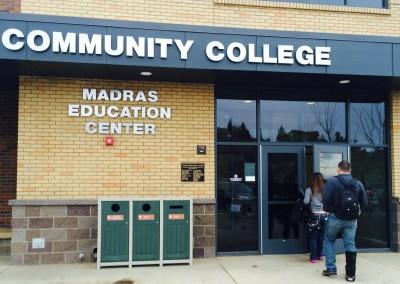
Enrollment numbers are on the rise at both the Madras and Prineville extensions. Both Madras and Prineville attribute the growing increase to the convenience the campuses offer and the feeling of home students have from an environment they know and understand, according to learning liaison Shirley Metcalf.
“In many ways, the students of both [Madras and Prineville] branches think of the facilities as a home away from home. They feel welcomed and that, I believe, contributes to the overall success both branches are experiencing,” Metcalf said.
Since the Central Oregon Community College Madras extension opened back in 2011, the enrollment number has been steadily escalating, with the COCC branch experiencing a 38 percent increase, the highest to-date. The trend has been attributed to the Madras extension expanding its current curriculum.
“We have made a real effort to provide students with more classes, and more mixed courses,” said Courtney Snead, Madras Campus coordinator. “The [COCC] branch has gone from offering nine classes the very first fall we opened, to now offering close to 24 classes students can choose from.”
Prineville has experienced a 20 percent enrollment increase. Here, the increment is mainly attributed to the convenience of having a new local campus, according to Suzy Kristensen, the Prineville campus coordinator.
“Students like having the local facility here, which makes it easy for them to attend classes, as opposed to having to commute to Redmond or even Bend,” Kristensen said.
The growth in student population is a result of the higher quality of learning that takes place within the walls of the classroom, according to Dr. James Middleton, president of COCC.
“When we see an increase like this it really speaks to us, telling us that we are doing something right,” Middleton said. “With the choices students nowadays have for a higher education, it really does show that COCC is a good source to fulfill and surpass those needs. Since we are local, we’re more affordable, but that doesn’t take away from the quality of education [students] receive to help achieve their goals.”
Having an increase of this size in student volume will not be affecting COCC’s legislative funding.
“At this point, it does not affect it in many ways because the state has frozen how much we get,” Middleton said. “Although, if the trend continues and we have an even bigger increase than what we’ve seen, then it would have to be revised for the 2014-2015 school year.”
Surges in attendance of this kind come with some challenges, but faculty and staff are working together to deliver the type of learning that has become a staple of COCC.
“The biggest challenge we face is delivering the same high-quality learning environment on the extensions as we do here in Bend,” Middleton said. “Class sizes are the biggest difference between the Madras, Prineville campuses and the Bend one. You may see a class size of 30 here in Bend, which is the norm, but in Madras that norm might be ten or 15.”
Teachers like sociology professor Del Cornett, who next semester will be instructing a course in Prineville, or math professor Doug Nelson, who teaches in Bend, Prineville and Madras, are setting examples to follow, Metcalf said.
“We are very much proud of our full-time tenure staff who not only teach in Bend but enjoy going to teach on the extensions,” Metcalf said. “It shows the level of commitment the faculty has to teaching students the very best way possible.”
Delivering an innovative approach to learning as well as a growth-encouraging environment seems to be the way to continue the enrollment increase, according to extension leaders Snead, Kristensen and Metcalf.
“Based on the success we’ve seen so far in both Madras and Prineville, I’m hopeful it will only get better,” Metcalf said. “We see a little increase, or in this case a lot every year, and I think next year won’t be any different.”
Brayan Gonzalez
The Broadside
[email protected]













